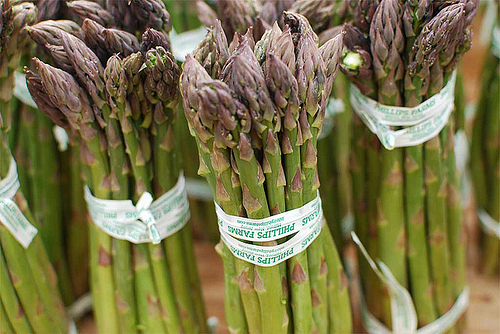Springtime dish: Asparagus
Asparagus is still, for the most part, a springtime food in America. Even though the global nature of our food network means that you can get out-of-season asparagus year round, it just isn't very good. Asparagus is best in springtime, when it is tender and fresh and often on sale due to its amazing yet short-lived abundance on the market.
Some people gravitate toward the fatter asparagus, under the misconception that "bigger is better." But the best asparagus is the smallest kind. The more narrow the asparagus, the younger and therefore more tender it will be. Look for asparagus spears which are no fatter than the diameter of a pencil.
The fatter the spear, the more woody and fibrous it is. But even the tender narrow spears get increasingly more fibrous as you get toward the cut end. Thus, for the best eating experience, you will want to chop off and discard the last few inches of the spears. (You don't HAVE to, of course. But I'm picky when it comes to asparagus texture, so I always do.) You can also peel them but I just don't have the patience.
There are a lot of ways to cook and serve asparagus, but I lean toward the simplest: A quick roasting in a pan on the stovetop over medium heat.
Start with either a splash of olive oil, or by frying a few slices of bacon in the pan and leaving the grease behind. The bacon method is more delicious, but arguably less healthy. When the pan is hot, add the asparagus as well as a generous portion of pepper. (If using olive oil, add a dash of salt as well.)
Cook them for about 10 minutes, turning them only once or twice. The longer they sit undisturbed in the pan, the better they will brown. They are done when the color is very vibrant, the spears are somewhat tender, and they have some good crusty bits. These are especially delicious with eggs and toast for brunch.
Image courtesy Flickr/Livin' Spoonful
